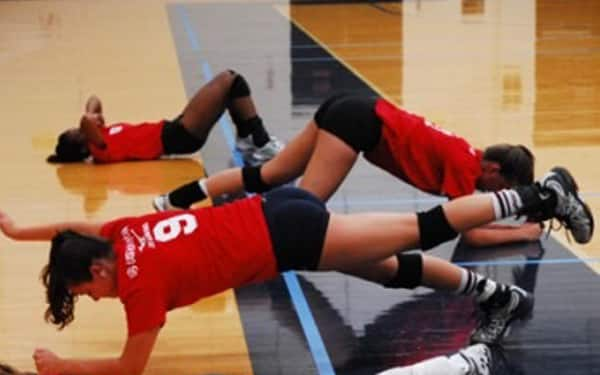
Originally published in VolleyballUSA, Spring 2011 issue.
The topic for today is one step removed from pass, set, hit but equally important for both indoor and beach volleyball players. I call it functional strength.
Serious volleyball players at all levels have routines that include practice as well as strength-and-conditioning training. But with crazy schedules – school, work and all of the other things that are part of our fast-paced lives – many players, young and not so young, fall a little short when it comes to doing volleyball-specific exercises that improve performance and reduce injury risk.
I see a lot of younger players who lack the necessary strength to hold a low body position for even 5 or 10 seconds. As you know, that position is very important in volleyball. For digging, passing and jumping. For covering the court most efficiently. And for performing key skills, like going down to get a ball that’s rebounding off the net.
What’s the remedy? I asked for the expert advice of fellow USA staff member Jill Wosmek, the U.S. Women’s National Team’s certified athletic trainer. She recommended five simple exercises that volleyball athletes should do if they’re not already following a similar program. None of these exercises require any weights, although if athletes get stronger and want more of a challenge, they can add dumbbells to the routines. They are:
Body-weight squats – Put your hands on your hips, feet about shoulder width apart. Bend at the knees until your thighs are parallel to the floor or a little lower and then jump. Do 10-12 of these, rest a minute and then do two more sets.
Side lunges – Again, your feet are shoulder width apart. Step sideways so the leg you’re stepping with ends up bent at about 90 degrees and your opposite leg is straight. Then push back to your starting position. Go the other way to complete a full rep. Do two or three sets of 10-12 reps. To make it volleyball specific, hold your arms out in a passing platform while you perform your lunges.
Forward lunges – With your feet together, step forward with one leg until the thigh of that leg is parallel to the ground. Push off with that leg and return to your starting position. Switch to the other leg to complete a rep. Do two or three sets of 8-10 reps. You can make this one volleyball specific too by holding a passing platform out in front of you when you’re doing each step.
Pushups – Depending on your level of strength, you can either start with regular pushups or you can do half pushups, where you have your knees on the ground instead of your feet. If you find that even a half pushup is too difficult, try pushing off a wall while standing up. Your feet should be about two feet away from the wall when you begin.
Planks – This exercise starts similar to pushup position except you wrest on your elbows and forearms with your elbows under your shoulders. Hold this position for a minute. As you get stronger, strive for two minutes. This is a great way to strengthen your core. If you want a greater challenge, start in standard push-up position and then rotate your body so one arm remains on the ground and the other points straight up toward the sky. This is called a lateral plank.
My suggestion is that you carve out a few minutes two or three times a week to do some of these exercises. I know you’re busy. But if you’re a student who’s crunched for time on a school day, you can multitask. Try doing some of your lunges and squats with a textbook in your hand. Nothing wrong with building your mind while you build your body.
If you’re an older player who enjoys the game on a recreational level, these exercises are good, too. And it’s also good if you do everything possible to play volleyball more than once every two or three weeks. By playing the game, you stay in shape, so you can cut down on the amount of time you spend at the gym. Volleyball is more fun anyway, right?
My dad, Las Kiraly, is a doctor, and he tucked volleyball into his workday for years and years as a member of what is known in his hometown of Santa Barbara, Calif., as the “Nooners Club.” I’m sure that very few people were aware that he wore a swimsuit under his dress suit while he was treating patients at the hospital. Come lunchtime, he’d bolt down to the beach for 90 minutes of play, then return to the hospital after a quick shower and a bite of lunch and finish his shift. During that hour and a half between noon and 1:30, the Nooners had priority on certain courts, which means they could give the boot to anybody – even a couple of Olympic gold medalists like Todd Rogers and Phil Dalhausser.
The bottom line is pretty simple: Play more – and do a few extra exercises – and you’ll not only be a better player but you’ll be in better shape, too. That’s a winning combination.
